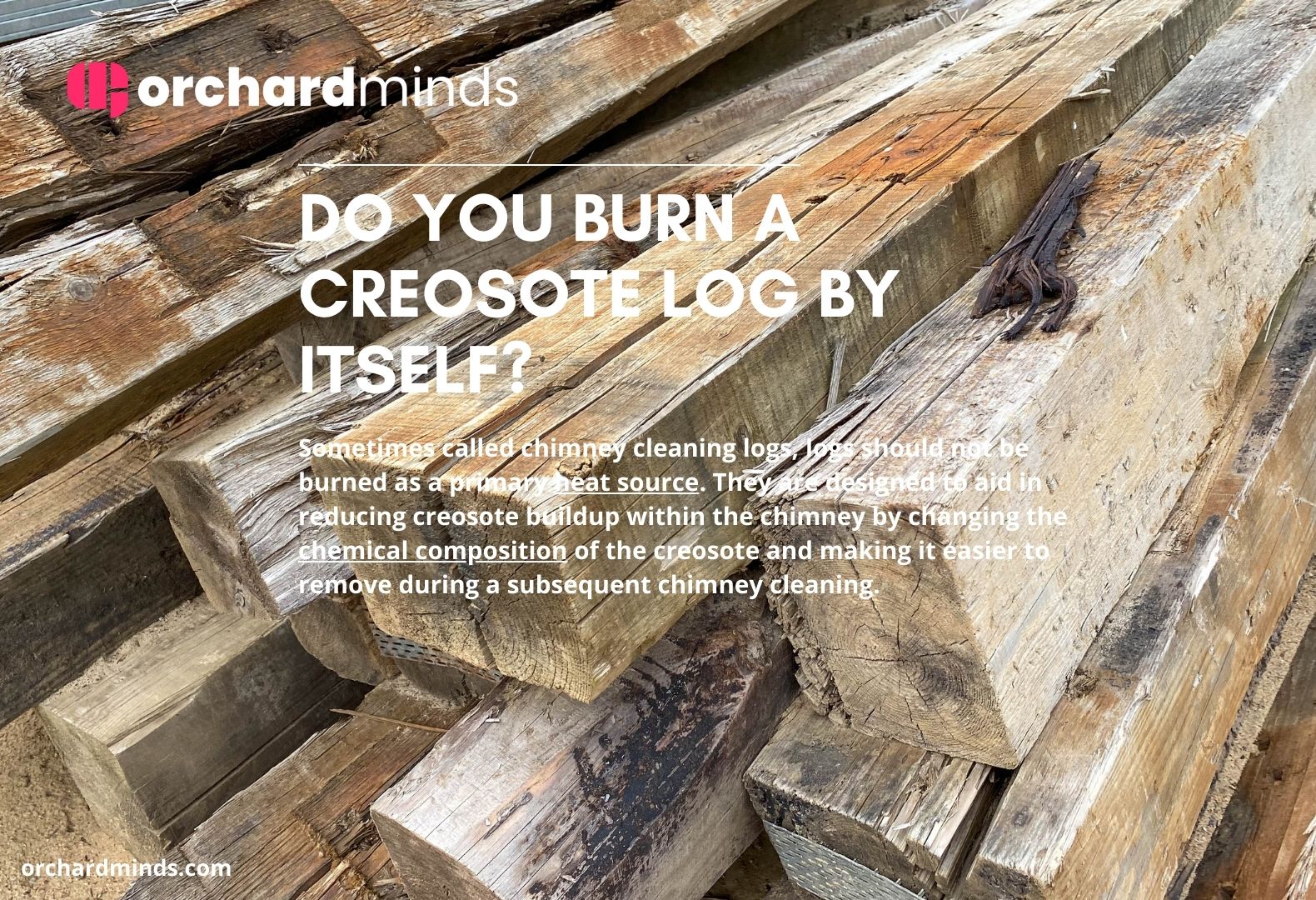Do you burn a creosote log by itself? Sometimes called chimney cleaning logs, logs should not be burned as a primary heat source. They are designed to aid in reducing creosote buildup within the chimney by changing the chemical composition of the creosote and making it easier to remove during a subsequent chimney cleaning. These logs should be used in conjunction with regular maintenance and cleaning practices, such as annual chimney inspections and cleaning by a professional, and they should not replace the necessary precautions for the safe and efficient use of your fireplace or stove.
What Do Creosote Sweeping Logs Do?
Creosote sweeping logs, also known as chimney cleaning logs or creosote-burning logs, are designed to help reduce creosote buildup inside the chimney. Creosote is a highly flammable and sticky residue that accumulates on the interior walls of a chimney when wood or other fuels are burned. Over time, this creosote can harden and become a fire hazard. Creosote sweeping logs work by altering the chemical composition of the creosote, turning it into a brittle, powdery substance.
Burning a creosote sweeping log in your fireplace or wood stove generates a high-temperature chemical reaction. This reaction causes the creosote to dry out and become more brittle, making removing it easier. The brittle creosote can then be loosened and removed during a subsequent cleaning, typically performed by a professional chimney sweep.
It’s important to note that creosote sweeping logs do not replace the need for regular chimney maintenance. They are a supplement to, not a substitute for, proper chimney care. Annual chimney inspections and cleanings by a qualified technician remain essential for ensuring the safety and efficiency of your chimney and fireplace. Creosote logs are most effective when combined with routine maintenance to help minimize the risk of chimney fires caused by creosote buildup.
Why Should I Consider Using Sweeping Logs?
It would help if you considered using creosote sweeping logs to help maintain a safer and more efficient chimney system. These logs can aid in reducing creosote buildup, which is a significant fire hazard, by transforming it into a more manageable form. By using sweeping logs in conjunction with regular chimney inspections and cleanings, you can improve the safety of your fireplace or wood-burning stove and reduce the risk of chimney fires. However, it’s essential to remember that sweeping logs are not a standalone solution, and professional maintenance remains crucial for ensuring the long-term health of your chimney.
How to Use a Creosote Sweeping Log
Using a creosote sweeping log is straightforward, but following the manufacturer’s instructions is essential. Here are the general steps for using a creosote comprehensive record:
- Check the Chimney: Before using a creosote sweeping log, ensure your chimney is free from blockages or obstructions. This is important for safety and proper ventilation.
- Select the Right Log: Purchase a creosote sweeping log from a reputable source, and make sure it is suitable for your type of heating appliance (fireplace, wood stove, etc.).
- Prepare the Fireplace or Stove: Open the damper for proper airflow. Removing large debris or ashes from the firebox ensures the log can burn freely.
- Read the Instructions: Carefully read and follow the instructions provided by the manufacturer of the creosote sweeping log.
- Light the Log: Ignite the creosote sweeping log as you would with any other firewood, following the manufacturer’s lighting instructions. It’s essential to use a match or lighter as directed by the instructions, as some logs require a specific lighting method.
- Monitor the Log: As the log burns, it will undergo a chemical reaction that transforms creosote buildup within the chimney. Pay attention to the log’s instructions regarding burn time and proper combustion.
- Extinguish the Fire: Once the log has burned completely, or as instructed, extinguish any remaining embers following the manufacturer’s guidance. This may involve dampening the fire or smothering it with ashes.
- Safety Precautions: Ensure the fire is entirely out, and close the damper to prevent drafts that might reignite any remaining embers.
- Schedule a Chimney Inspection and Cleaning: A few days after using the creosote sweeping log, schedule a chimney inspection and cleaning with a professional sweep to remove the loosened creosote and ensure the safety and efficiency of your chimney system.
Remember that creosote sweeping logs are not a substitute for professional chimney maintenance but supplement regular inspections and cleanings. Using them as part of a comprehensive chimney care routine can help minimize creosote buildup and enhance the safety of your heating appliance.
Do I Still Need to Hire a Chimney Sweep?
Even if you use creosote sweeping logs, you should still hire a professional chimney sweep for regular inspections and cleanings. Creosote logs are a helpful addition to chimney maintenance but are not a standalone solution. A chimney sweep provides essential services, including:
- Comprehensive Inspection: A professional chimney sweeper can thoroughly examine your chimney and heating appliance to identify any structural issues, blockages, or safety concerns.
- Effective Cleaning: Creosote logs may help break down some creosote, but a professional chimney sweep can thoroughly remove any remaining buildup, ensuring your chimney is safe and efficient.
- Safety Assurance: Chimney sweeps can detect and address potential issues that may not be resolved by using creosote logs alone, such as cracks, loose bricks, or damaged flue liners.
- Preventing Hidden Problems: Chimney sweeps can also address issues beyond creosote buildup, such as bird nests, leaves, or other blockages that creosote logs may not address.
While creosote logs can aid in reducing creosote accumulation and promoting safer operation, they should be used as a supplementary measure alongside regular professional chimney maintenance. This combined approach helps ensure the long-term safety and efficiency of your chimney and heating appliance.
FAQs about do you burn a creosote log by itself?
Indeed, here are some frequently asked questions (FAQs) about using creosote sweeping logs by themselves:
Can I burn a creosote log by itself as a source of heat?
No, creosote logs are not designed to be used as a primary heat source. When used with regular maintenance and cleaning, they are meant to help reduce creosote buildup within the chimney.
How do creosote logs work?
Creosote logs work by undergoing a chemical reaction when burned, transforming hardened creosote into a more brittle form. This facilitates its removal during a subsequent chimney cleaning.
Are creosote logs a replacement for professional chimney maintenance?
No, creosote logs should not replace the need for professional chimney inspections and cleanings. Regular maintenance by a qualified chimney sweeper is essential for safety and efficiency.
How often should I use creosote logs?
Follow the instructions provided by the manufacturer of the creosote log, but typically, they are used on an as-needed basis, which may vary depending on creosote buildup.
Do creosote logs prevent chimney fires?
Creosote logs can help reduce the risk of chimney fires by breaking down creosote. However, they should be used with other safety measures, including proper maintenance and safe burning practices.
Are all creosote logs the same?
Different creosote logs may have variations in their formulations and burning instructions. It’s essential to follow the specific guidelines provided by the manufacturer of your product.
Can I use a creosote log in any heating appliance?
Make sure to choose a creosote log suitable for your heating appliance. Some records may be designed for wood stoves, fireplaces, or specific types of chimneys, so check the product label for compatibility.
Do creosote logs have any safety precautions or considerations?
Always follow the safety instructions on the product’s packaging and use them in a well-ventilated area. Ensure the fireplace or stove is working well before using the log.
How is a creosote log working?
A creosote log’s effectiveness may take time to be visible. The best way to confirm their impact is during a subsequent chimney inspection and cleaning, where the loosened creosote can be removed.
Can I install a creosote log, or should I call a professional?
Creosote logs are typically user-friendly, but following the manufacturer’s instructions is essential. If you have any doubts or concerns, it’s advisable to consult a professional chimney sweeper for guidance and assistance




Leave a Comment